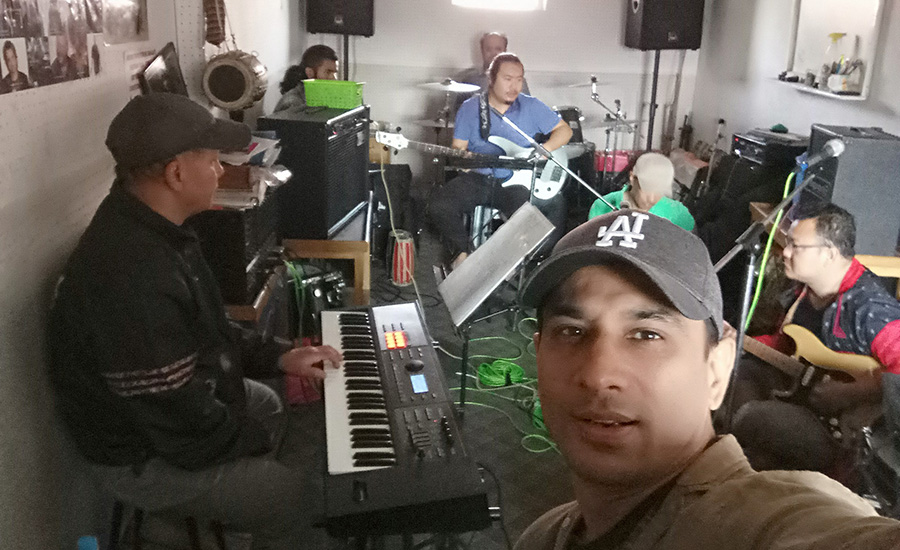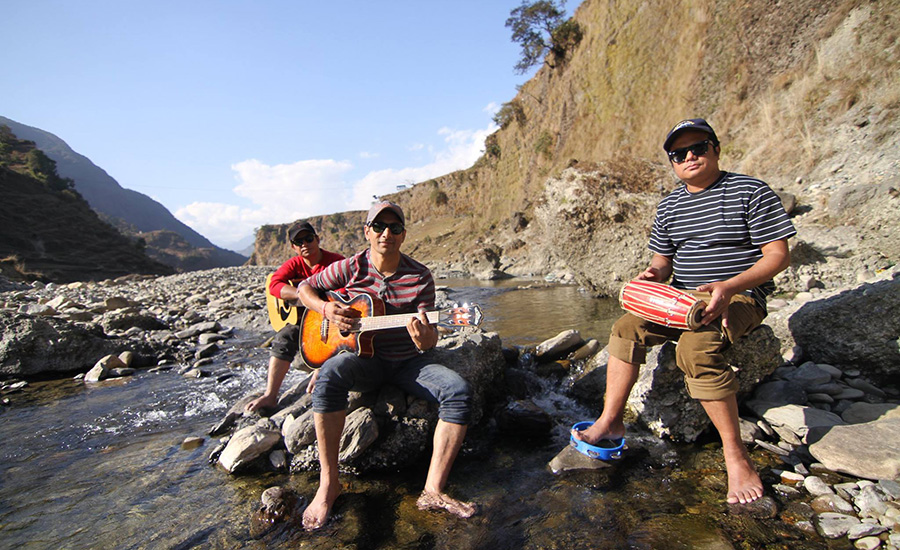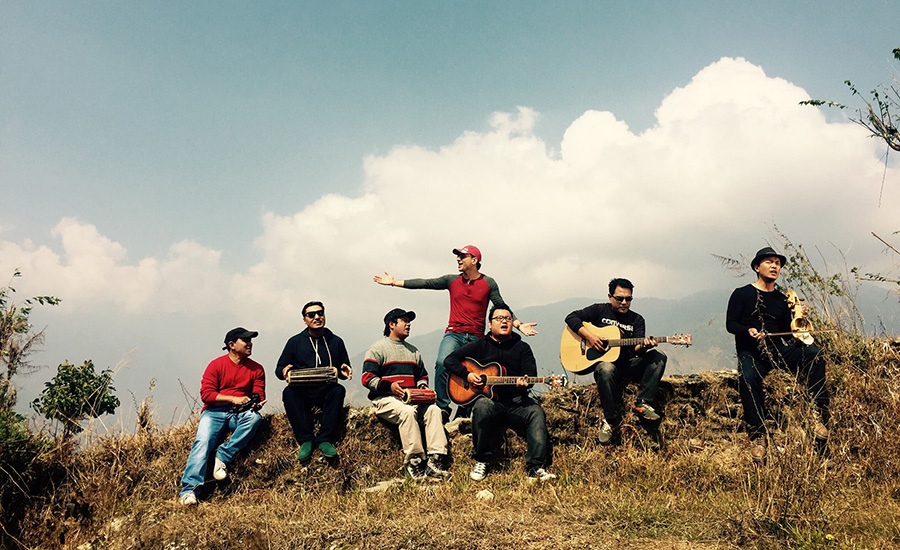As Om Padme Hum is chanted in the background, the colourful lungtars (Buddhist prayer flags) fluttered in the air and the burning incense filled the ambience. In the foreground was the six-foot-tall, heavy-built Bibek Shrestha with a big smile on his face.
Bibek Shrestha is the man with a soothing, magical voice that enthralled the people in the 1990s. People gravitated towards him because of his voice whereas the vagabonds used to lose themselves in his music. Kandara’s songs Bideshiyera Gayin Uni, Phulchoki Ko Dandaima, Timi Pari, Lekaki He Maya, Tagaroma Rumal Rakhi and Hong Kong Pokhara–all used to be played in every nook and cranny of the city as well as in all gatherings and events.
It was an era where bands were being formed in every community. It was the time when people started holding concerts, doing song recordings and producing tapes, with music blasting in full volumes. Some people did not like such a trend, and Kandara came to the rescue of those who did not like western music and appeased not just the youth but also the older generation.
Thus started the era of Kandara.
A toss of luck
Bibek Shrestha started singing professionally when his seniors from school proposed he sang a song for them. They took Shrestha to a recording studio, the first one he saw in his life. The 16-year-old Shrestha recorded five songs.
There, he first practised singing and recorded Chanchale Kanchhi, which also became the album name.

He also credits his career to his classmate from Pokhara, Sunil Thapa. Thapa, in school, was his cheerleader who matched Shrestha beat by beat as he drummed the desk. For a drama, Thapa even wrote a song “Aaja Bholi Raat Byujhayi Rahancha” and then 13-year-old Shrestha sang it.
At school, the duo had even created a club where as many as 50 people gathered and participated in musical and theatrical performances, exploring their interest in different musical instruments. The club members were so immersed that they would reach home just for meals or to do homework.
Shrestha, who had an interest in football and cricket too, would take time to go play the sports outside the club time.
Many club members created their separate bands including 24 Carat, which included people with an interest in the genre of rock music. Deepak Raj Mulmi, Bijay Gurung, Buddharaj Bajracharya, Sunil Bhattachan and Anand Tajiya were in the band. With time, the band 24 Carat then turned into Kandara.
Once the lyrics were ready, they would be engrossed in it. They would sing songs, fill tunes and practise. Thereafter, they would record with ease and then edit the songs for months at end. And, one could always feel the amount of effort they had put into every song. Their songs always boosted Kandara’s journey.
The growing impression
The first album was good as expected. But, as soon as their second album Dada Pari hit the market, it went viral; the cassettes were sold rapidly and the song started getting played repeatedly on all radio stations, at restaurants and even on public vehicles.
From that point of their journey to Hong Kong Pokhara, their success graph skyrocketed and they have not looked back. Even in the era of no internet, no mobile phones or FM stations, people waited for the songs on a few programmes on Radio Nepal. “I would wait for my name to come up on the radio. It was a privilege,” says Bibek Shrestha.
The band’s impression landed them their first concert in Butwal, in 1996. The hall was small, but that did not stop Kandara’s fanbase from pouring into the hall. Half the audience listened to Kandara live.
That day, the band performed not just once but twice. And, Bibek Shrestha had to sing over 15 songs in one concert. It means, on that particular day, he sang some three dozen songs.
After the stress and fatigue, he fell sick. But, that also meant concerts were arranged for them in the evening.
He became sick due to the heat and the pressure of the stage.
Then, the wave of concerts started and Kandara even performed abroad for the first time in West Bengal of India.
But a late recognition

Bibek Shrestha was very young when he first tasted fame, but his interest in music was there from the beginning. He was born in Pokhara and grew up in Waling of Syangja. When he used to board the public bus, he would always check if the buses would play music or not, always look for a tape recorder in the bus and would only travel in the bus that would play songs.
When any music album got released, no one dwelled deeply on marketing the album like today. For that time, public transport was the only reliable means to spread the songs everywhere. Most of the songs of that time that got viral were heard and liked by people using public buses.
It also meant that it was a time people had to imagine what a singer would be like just by listening to their voice. There was no social media, no YouTube, no television; only audio cassettes were heard everywhere. People would wonder: who is the singer? What are the musicians like? Who played the instrument?
Bibek Shrestha was the main vocalist of the band, but many people would love the song but not know that he sang the songs. On top of that, on the first cassette cover, he was standing on the sides whereas Sunil Thapa was in the middle, well-dressed. So, many people thought that Thapa was the singer instead.
The audience saw the singer’s full appearance only after the popularity of television and music videos.
The era of music videos

When Kandara’s music was reaching its peak of popularity, the trend of music videos was also on the rise. So, Kandara also indulged in it.
They were called to Kathmandu for filming. When they reached the location, the director played the song and said “Now dance, boys!!!” And, they started moving, dancing to their own tunes. He remembers, “There was no trend of doing makeup either.”
Even after the music video was ready, they had to wait till it was broadcast on television. People who loved the music bought the cassettes and would play it on loop.
Meanwhile, their names and photos started being printed in newspapers including the most popular weekly tabloid, Saptahik, which was a complete package of entertainment, published every Friday.
Another attraction of the publication was the weekly list of the 10 most popular songs. Kandara’s song Chanchle Kanchhi was also included in the tenth number of the list. Next week, the song climbed the charts to the eighth position. The song was listed together with Ramkrishna Dhakal’s Risaunda ni Aaphnai and Nepathya band‘s Chhekyo Chhekyo Deurali Danda.
But, the industry was limited. Artists or bands used to get royalties from the sale of the cassettes, yet the companies did not have a transparent system to account for how many cassettes they produced and how many they sold. Even with doubtful records, Kandara’s first cassette was sold to millions and with the subsequent albums, Kandara rose to fame. From Hong Kong Pokhara to Tagaroma Rumal Rakhi, the band created a glorious history.
Times have changed
When the music changed, the style and language of the songs also changed along with the technology. Bands held more concerts and selling cassettes became history.
The folk-pop music market has slowed down and Kandara got affected too. And, unfortunately, the musical group that was once at the peak of the 1990s got sidelined.
After a long hiatus, the band released an album Bhedagothaimaa. But, that could not perform like before.
At this time, Kandara are again gearing up to make a comeback. They have announced their new landmark with their new management structure. They are ready to have a commercial partnership with Nepgasm that will handle the song and video production of Kandara as well as manage their concert.
This story was translated from the original Nepali version and edited for clarity and length.
The post Kandara: The band that ruled the Nepali music scene in the 1990s appeared first on OnlineKhabar English News.
Comments
Post a Comment